
GrafanaCON 2023 Day 1 Recap: Grafana 10 release, Grafana Loki updates, IoT monitoring, and more
From IoT monitoring to green IT, the first full day of GrafanaCON 2023 covered a lot of ground.
It all kicked off with the keynote address, where Torkel Ödegaard, Grafana Labs CGO and co-founder — and the creator of Grafana — officially unveiled our latest major release, Grafana 10, alongside Director of Engineering Mihaela Maior. Grafana Labs CEO and co-founder Raj Dutt and co-founder Anthony Woods also hit the stage to showcase some exciting new announcements about Grafana Cloud.
But the excitement didn’t stop there. A series of live virtual sessions covered recent updates to Grafana Loki and Grafana Agent, provided project roadmap details for Grafana Pyroscope, and highlighted the unique and creative ways community members use Grafana dashboards to monitor their most critical data sources — even those in outer space.
If you didn’t get a chance to watch Day 1 of GrafanaCON 2023, here’s a quick look back at what you missed. You can also access session recordings on-demand.
Opening Keynote
The keynote Tuesday morning marked the official start to GrafanaCON 2023, streaming live from Stockholm, the birthplace of Grafana. Raj Dutt looked back at the past year in open source, announced the winners of our first-ever Golden Grot community dashboard awards, and previewed what’s to come for Grafana and Grafana Cloud. Torkel Ödegaard and Mihaela Maior then unveiled some of the latest features available in Grafana 10.
Access the on-demand session here.
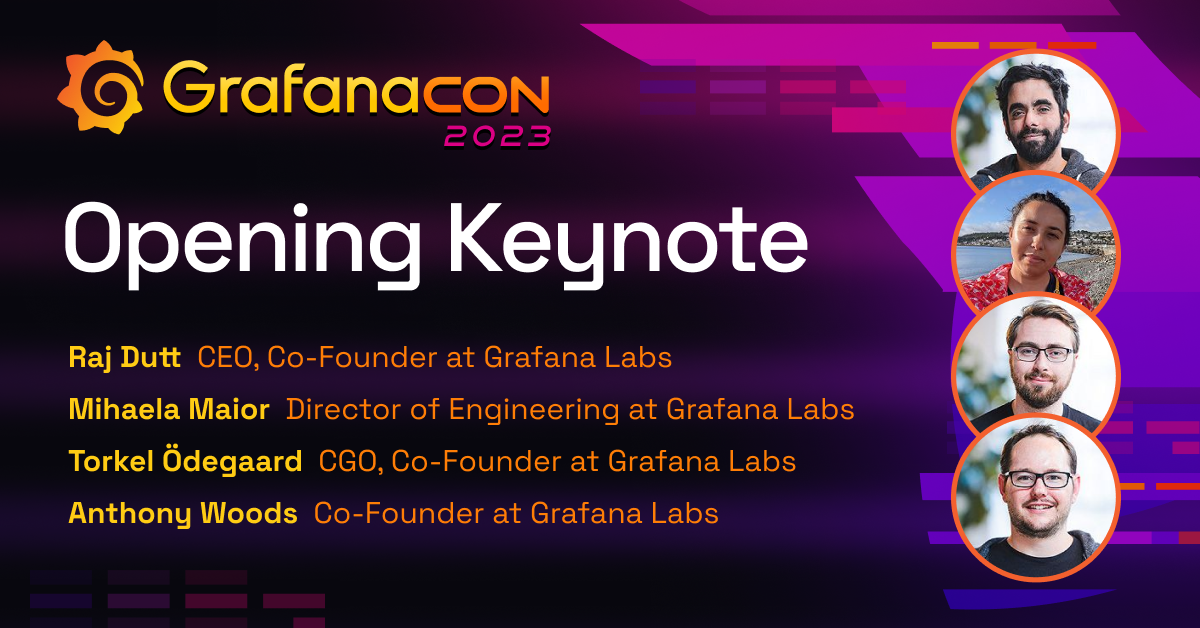
Using Grafana to track satellites with the Libre Space Foundation
The Libre Space Foundation is a non-profit organization developing and supporting open source technologies for space missions. In this session, LSF Core Contributor Patrick Dohmen discussed how SatNOGS, the biggest open source network of satellite ground stations, uses Grafana dashboards to help research and academic teams identify and track their satellites and make use of the data collected. Grafana dashboards are a crucial connection point for the community, and Patrick showed how you, too, can use Grafana to participate in hunting satellites.
Access the on-demand session here.

How Loki’s new TSDB index and Grafana come together to improve performance and lower costs
In this session, Grafana Loki contributors Kavi Kanagaraj and Travis Patterson explored the improvements in cost and performance seen since the team transitioned all of Grafana Cloud Logs, the fully managed Loki-as-a-service product from Grafana Labs, to use Loki’s new TSDB index.
“The TSDB index format gives us a very nice feature [in that] it’s actually built for the data model similar to Loki,” explained Kanagaraj in the session. “So, whatever goes into the Loki index — which is basically all the labels, key-value pairs — TSDB is built just for that purpose. So with TSDB, we can store these labels as effectively as possible.”
Kanagaraj and Patterson also discussed some exciting new updates to how queries are rendered in Grafana. Spoiler alert: Spend less time waiting for results!
Access the on-demand session here.
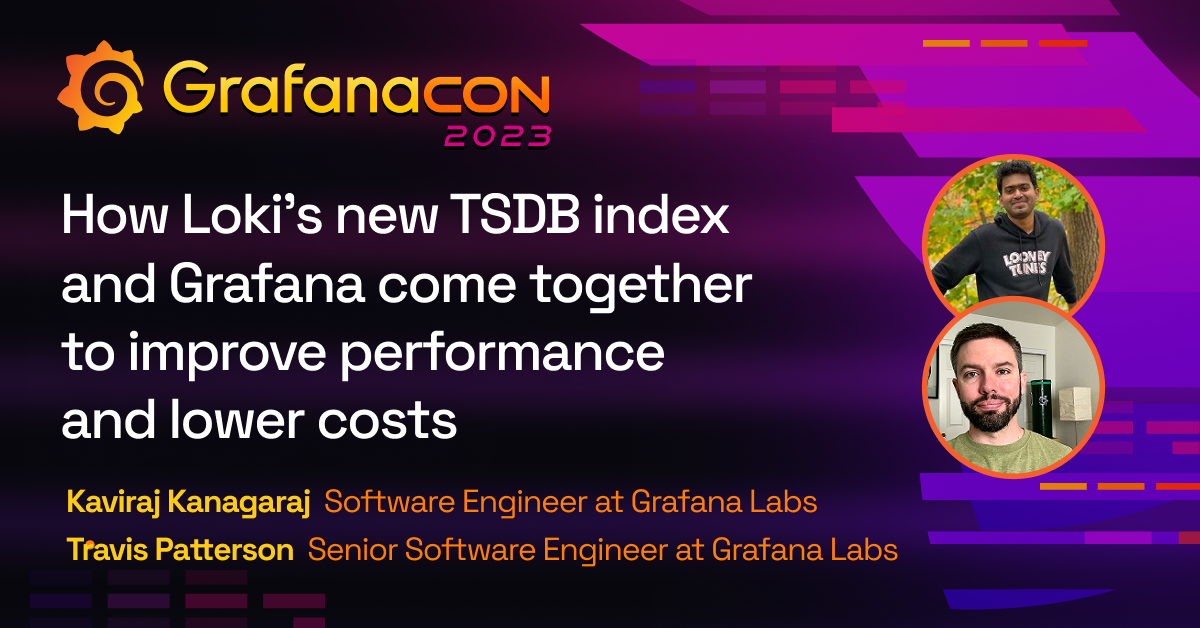
Transforming IT and business flows at DHL Express with Grafana, k6, and Prometheus
At DHL Express Switzerland, a unit of the international logistics and shipping company, traditional IT and business support was cumbersome, disparate, and reactive — and had high associated costs. In this session, Djamel Djedid, Head of Application Development & Integration, and Michael Lerch, Lead Architect, discussed how selecting the open source Grafana observability stack and Prometheus, as well as the performance testing tool Grafana k6, enabled DHL Express Switzerland to transform support issues into massive business and IT benefits.
“[The Grafana] observability stack really provided many benefits — benefits in resolving issues faster, benefits in minimizing, as well, the overall effort to resolve issues, but also really expanding our observability to go beyond traditional IT monitoring,” Djedid told attendees.
Access the on-demand session here.
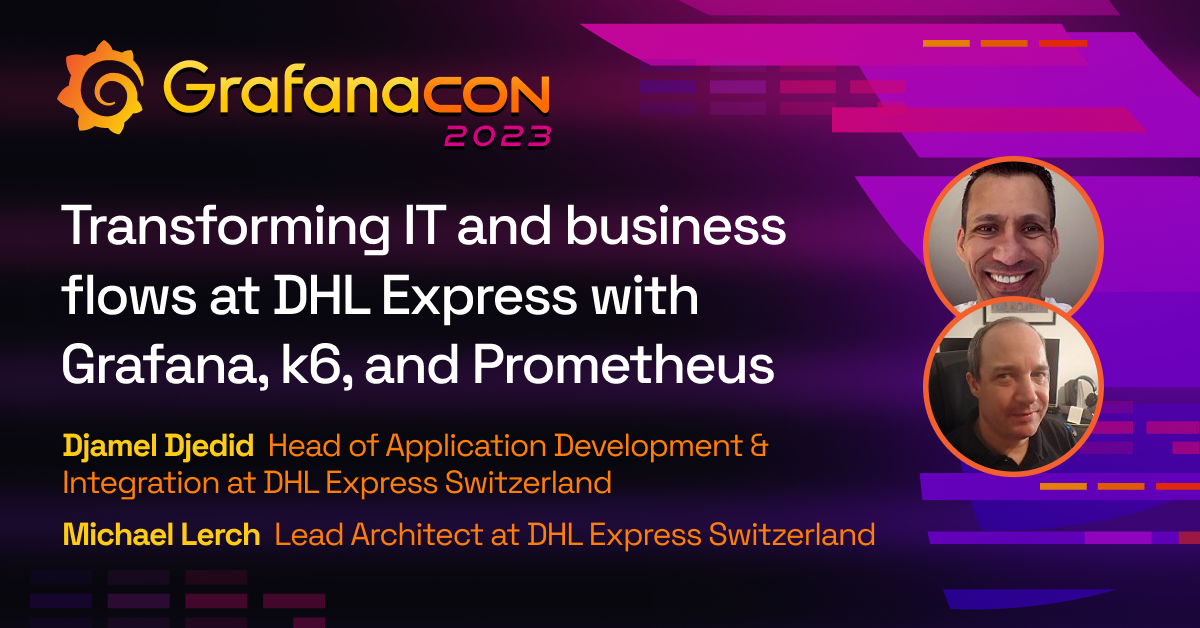
Homelab hacking: Grafana on an LED matrix display
To begin this session, Kristina Durivage, Senior Software Engineer at Grafana Labs, posed an interesting question to GrafanaCON attendees: “What if we wanted to take our favorite data and display it ambiently, enjoying its beauty as much as one would admire a painting?”
Then, Durivage and her colleague Ed Welch, Principal Software Engineer at Grafana Labs, explained how to do just that. Geared toward true dashboard lovers, this session demonstrated how to build an IoT project to display data on an esp32-powered LED matrix display.
Access the on-demand session here.

Reducing data center energy usage with Grafana: A green IT success story
Sentry Software operates its own data center as part of its business helping companies with IT monitoring solutions. In this session, Sentry CEO Bertrand Martin shared how Grafana helped the company reduce its data center’s electricity usage by 15%.
With Europe facing an energy crisis, Sentry Software decided to leverage Grafana and OpenTelemetry to analyze its energy footprint and identify opportunities for optimization. The team was able to increase its server room’s temperature from 18°C to 27°C while still maintaining optimal conditions, resulting in significant energy savings. In this session, attendees learned how to replicate Sentry Software’s success to achieve their organization’s own sustainability goals.
Access the on-demand session here.
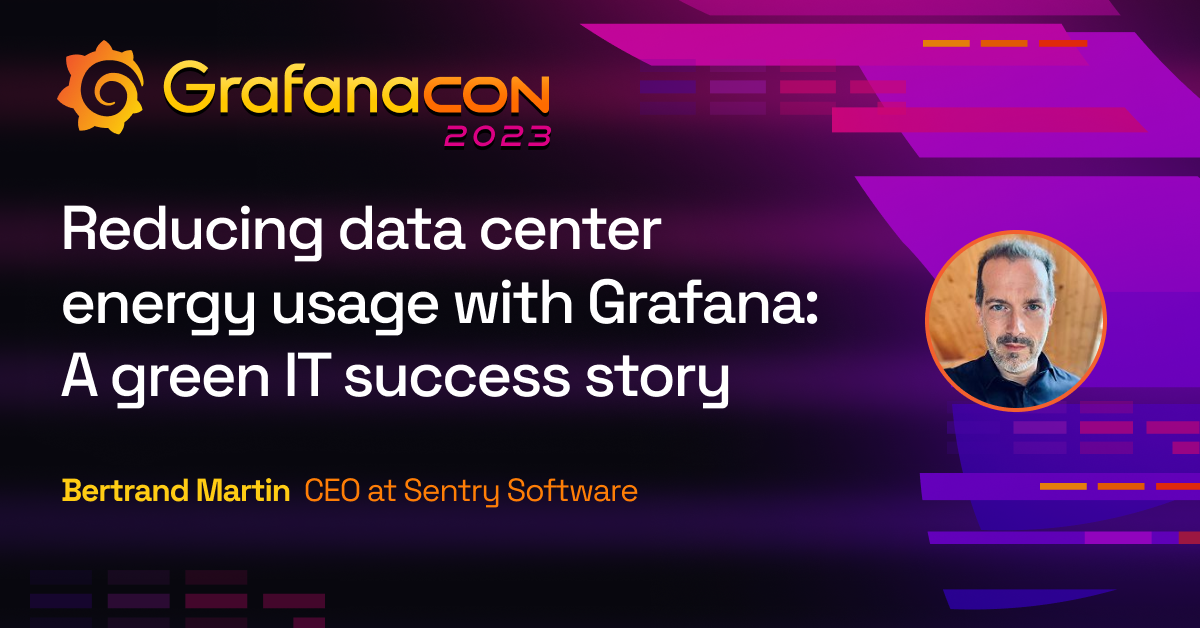
Continuous profiling with Grafana Pyroscope: developer experience, flame graphs, and more
Did you hear the news? Grafana Phlare and Pyroscope are merging to form a new open source continuous profiling project under the name Grafana Pyroscope. In this session, the project leads shared their philosophy of how continuous profiling can improve developer experience, helping engineers gain a deeper understanding of their systems, quickly identify and resolve issues, and ultimately, deliver better software faster.
“[With continuous profiling], you are able to, kind of, go back in time, go forward in time, and compare different time slots with each other. That makes it even more powerful,” explained Christian Simon, Principal Software Engineer at Grafana Labs. “You can find resource consumption issues where you don’t really expect them to be, and through that, you can locate them and debug them much faster.”
The speakers also provided an update on the new project roadmap and progress so far, including recent improvements around performance and scale in the continuous profiling database, flame graph visualization of profiling data in Grafana, and ease of use for profile collection.
Access the on-demand session here.
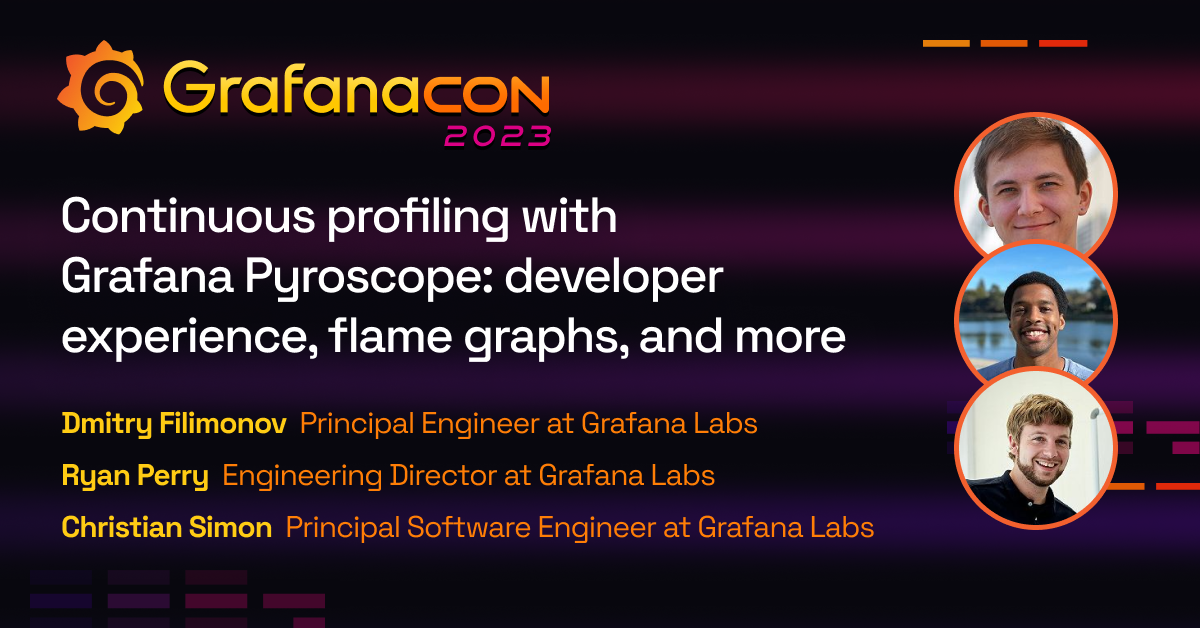
Monitoring a fleet of IoT farms with Grafana Cloud
If you had a fleet of all-in-one indoor farming solutions deployed across the world, how would you tackle the challenge of monitoring these distributed agricultural systems?
In this session, Amandeep Ratte, Head of Data Science at a multinational AgTech company, answered that question and more as he walked through how his team leveraged Grafana Cloud to build a way to track their international fleet of IoT farms with dashboards that offer fleet-wide aggregate views, detailed device views, and a robust health check architecture. Ratte showed how the company’s entire Grafana Cloud stack is deployable via Terraform; how they use AWS Lambda functions, Lambda layers, and AWS Timestream to perform scheduled health checks that are testable; and how they use JSON API community plugins to create custom endpoints to expose relevant business logic and meta-data to organize their views.
Attendees learned about Terraform in the context of Grafana Cloud, horticultural diagnosis, how to leverage Grafana plugins to access internal APIs for meta-data, and a framework to iteratively convert common visual/graphical diagnosis into automated, testable health checks.
Access the on-demand session here.

Creating a high-performance data culture with Grafana
So you are sitting in front of Grafana. Now what? Grafana can do much more than provide actionable insights; it can create a high-performing culture around that data, and the actionable insights it generates.
“I really want to advocate for an observability strategy and dashboard design that brings out the important data right as you visit that dashboard,” said Grafana Labs Solution Engineer Stephanie Closson.
In this session, Closson explored the softer side of Grafana: how people interact with data, the curiosity it generates, and how that natural curiosity can set the stage for a high-performance culture where millions of dollars could be saved.
Access the on-demand session here.

Expanding Grafana’s big tent with Grafana Agent
Grafana Agent is the open source telemetry collector built for sending your metrics, logs, and trace data to the Grafana stack so you can visualize and correlate all your disparate data in Grafana dashboards. As such, it’s an important part of Grafana’s big tent philosophy.
Ahead of the 1.0 release of Grafana Agent later this year, the team has introduced Grafana Agent Flow, a new way to configure the Agent that enables faster iterations and the ability to add components to handle different signal types and vendors easily. In this session, attendees learned about Agent Flow and the approaches the Agent team is taking to ensure that the Agent is the best data collector for signals regardless of vendor or platform.
Access the on-demand session here.

How NVIDIA’s Threat Hunting process leverages Grafana and Loki for log analysis at scale
The security team at NVIDIA, a leading manufacturer of GPU and AI hardware and software, has developed a powerful Threat Detection System (TDS) for analyzing security logs at scale to detect malicious activity. The team relies on Grafana and Grafana Loki to provide a robust platform for analyzing different data types to identify and respond quickly to any suspicious activity.
In this session, Singh Hora and Pradeep Thalasta, Senior Software Engineers at NVIDIA, discussed the current architecture of NVIDIA’s Grafana-Loki stack, and shared best practices for deploying and managing the stack for scale and multi-tenancy.
Access the on-demand session here.
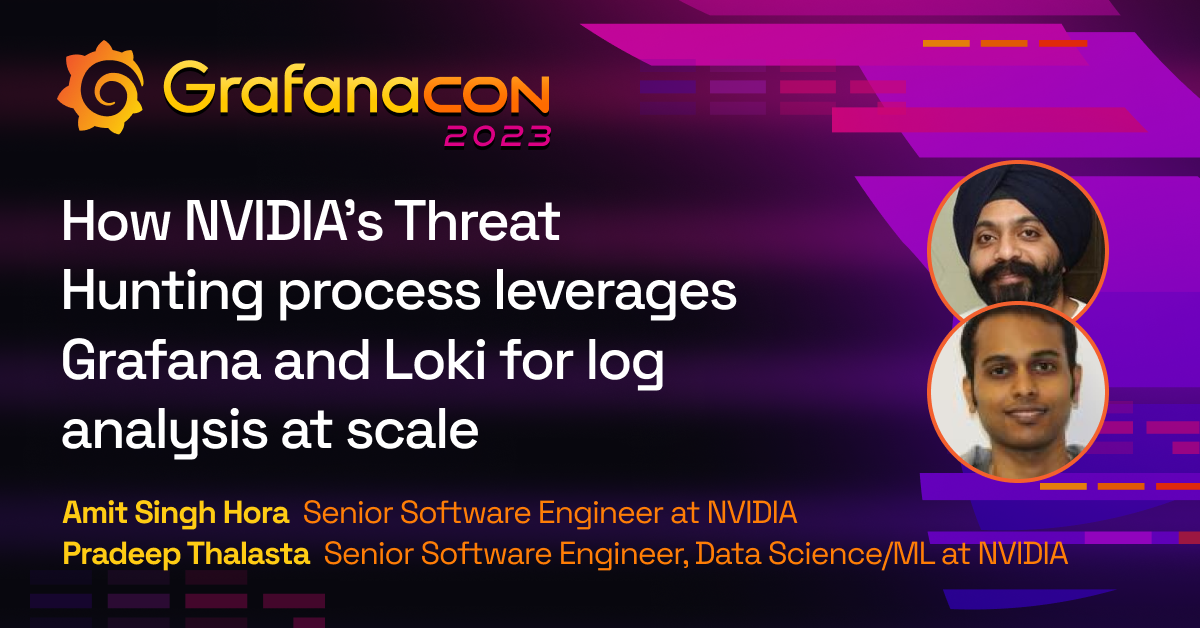
How ESnet built Grafana plugins to visualize network data
ESnet (Energy Sciences Network) at Berkeley National Lab is a high-performance network backbone built to support scientific research, allowing scientists to collaborate and perform research without worrying about distance or location. In order to make sure its network is running as smoothly as possible, the ESnet team uses Grafana to visualize and understand telemetry data collected within its Stardust Environment, and thus predict capacity needs and easily view traffic surges on the infrastructure. The team has also built several visualizations tailored to ESnet’s network analytic use cases and contributed them to the Grafana community: Sankey Diagram, Slope Graph, Bump Chart, Chord Diagram, and Matrix panel.
“We love a lot of the built-in [Grafana] visualizations, but there have been a few cases where we’ve wanted something slightly different — and we’ve had some success writing our own,” said Andy Lake, Network Software Engineer at ESnet.
In this session, Lake joined his colleagues and fellow engineers Katrina Turner and Dan Doyle to explore why ESnet needed these new visualizations, how they built them, and how others in the community can use them. Having recently deployed Grafana Enterprise, the team also touched on its future work, including utilizing the new authorization and team features to give ESnet users customized login and dashboard experiences on a single instance.
Access the on-demand session here.
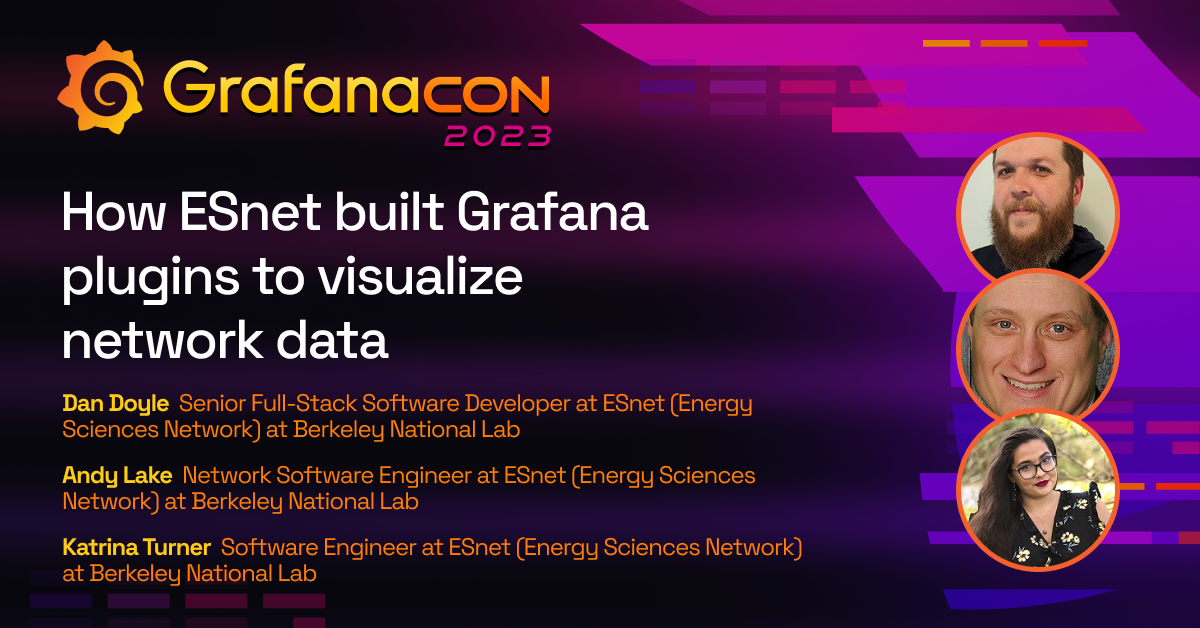
More from GrafanaCON 2023
Don’t miss these upcoming sessions focusing on all the major features in Grafana 10, a look at Grafana k6 and Grafana Mimir, and different Grafana use cases from NASA to a Grafanista’s home security system, and more.
Deep dive into Grafana 10
Wednesday, Jun 14 07:00 PDT, 16:00 CEST, 14:00 UTC
Monitoring high-throughput real-time telemetry data at Daimler Truck with the Grafana Stack
Wednesday, Jun 14 08:00 PDT, 17:00 CEST, 15:00 UTC
What’s new in docs: improvements, how to contribute, and more
Wednesday, Jun 14 08:30 PDT, 17:30 CEST, 15:30 UTC
How to build dynamic, customizable dashboards with Grafana Scenes
Wednesday, Jun 14 09:15 PDT, 18:15 CEST, 16:15 UTC
How Grafana and Tempo 2.0 make it easier to explore distributed traces
Wednesday, Jun 14 09:45 PDT, 18:45 CEST, 16:45 UTC
How Grafana k6 helps you break your APIs to make them stronger
Wednesday, Jun 14 10:15 PDT, 19:15 CEST, 17:15 UTC
Grafana’s new navigation: A journey of user experience, design, and continuous improvement
Wednesday, Jun 14 11:00 PDT, 20:00 CEST, 18:00 UTC
Why Grafana Mimir is better than ever for time series data of all shapes and sizes
Wednesday, Jun 14 11:30 PDT, 20:30 CEST, 18:30 UTC
Automated performance modeling with NASA Open MCT, Grafana Cloud, and k6
Wednesday, Jun 14 12:00 PDT, 21:00 CEST, 19:00 UTC
Get started with home automation with Raspberry Pi and Grafana Cloud
Wednesday, Jun 14 12:30 PDT, 21:30 CEST, 19:30 UTC
Using Prometheus, Python, and Grafana Cloud for data-driven triathlon training
Wednesday, Jun 14 13:00 PDT, 22:00 CEST, 20:00 UTC
On-demand sessions will be available at the end of each day from the GrafanaCON 2023 events page. And, if you’re looking to connect in-person with other members of the Grafana community, sign up for one of our GrafanaCON 2023 Local Meetups.



